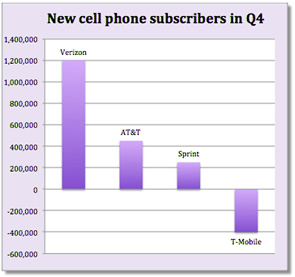With Apple's latest handset now officially in the hands of three major carriers, Verizon currently leads AT&T and Sprint with the most new postpaid subscribers (ie. contracts) signing up to get the iPhone 4S. Verizon is expected to add around 1.2 million subscribers this quarter, compared to AT&T's 450,000 newly indentured customers.
While Verizon is enjoying the freshest influx of contractually obligated subscribers, AT&T has sold the most units, shipping over 6 million iPhone 4S handsets this quarter alone. Verizon and Sprint sold 4 million and 2 million, respectively.
The triumvirate of carriers selling the iPhone has left T-Mobile out in the cold though. Analysts predict the company will shed roughly 400,000 customers by the end of the year. Verizon, Sprint and AT&T are expected to pick up most of those defections. Recent times have been rough for T-Mobile.
Sprint has invested a great deal of resources in order to offer Apple's smartphone, but sales of the device have helped to partially reconstitute a once stale Sprint. By the end of the quarter, iPhones will account for nearly a third of Sprint's handset sales and about six percent of its new subscribers. It is said that Sprint still needs more subscribers to justify the deal, but so far the company is off to a good start.
Somewhat ironically, Verizon has been pushing discounted 4G Android phones to its customers with better data plans. However, despite the greater value of competing devices, customers continue to gobble up iPhones. It is thought that Verizon would rather see customers snap up Android handsets because per contract, Apple's cut is nearly double that of Android phones.
Interestingly, Verizon subsidizes "only" $350 for new iPhones sold with a contract, which is the best deal any carrier gets from Apple. AT&T and Sprint cover slightly more per subsidy at $375 and $400 per iPhone, respectively. Android phones cost carriers less at $150-250, per contract.
